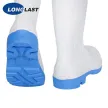What's different about food processing boot?
Food processing boots, also known as food industry boots or food safety boots, are specialized footwear designed for use in environments where food is processed, prepared, or handled. These boots are subject to specific standards and requirements to ensure they contribute to maintaining high levels of hygiene and safety in the food industry. Here are some key features that differentiate food processing boots:
Material Composition: Food processing boots are typically made from materials that are resistant to water, chemicals, and oils. The materials used often meet regulatory standards for food safety, ensuring that they don't introduce contaminants to the food processing environment.
Hygienic Design: These boots are designed with hygiene in mind. They often have smooth surfaces and minimal seams, reducing the likelihood of harboring bacteria or debris. The lack of crevices makes them easier to clean and sanitize, preventing the accumulation of contaminants that could compromise food safety.
Waterproof and Moisture-Resistant: Food processing environments may involve exposure to water, liquids, and moisture. Food industry boots are constructed to be waterproof, preventing water and other liquids from entering the boots. This feature is crucial for maintaining a dry and sanitary working environment.

Slip Resistance: Slip-resistant soles are a common feature of food processing boots. The floors in food processing facilities can become slippery due to water, oils, or other liquids. Slip-resistant soles help prevent accidents and injuries, ensuring the safety of workers in the food industry.
Antimicrobial Properties: Some food processing boots incorporate antimicrobial treatments to inhibit the growth of bacteria and fungi. This helps control the spread of microorganisms in the working environment, contributing to food safety and hygiene.
Compliance with Food Safety Standards: Food processing boots must meet industry-specific standards and regulations, such as those set by food safety agencies or organizations like the Food and Drug Administration (FDA). Compliance ensures that the boots are safe for use in food handling and processing.
Easy to Clean and Sanitize: The design of food industry boots facilitates easy cleaning and sanitization. This is essential for preventing cross-contamination and maintaining a hygienic environment. Some boots may be resistant to common cleaning agents and disinfectants.
Color Coding: In some cases, food processing boots are color-coded to indicate different areas within a facility or to distinguish between different job roles. This practice helps prevent cross-contamination by ensuring that boots worn in specific areas do not carry contaminants into other sections.
Steel Toe and Toe Cap Options: In environments where there is a risk of heavy objects falling, steel toe or toe cap options may be available to provide additional protection for the toes.
Comfort: While prioritizing safety and hygiene, food processing boots are designed to provide comfort for workers who may be on their feet for extended periods. This includes features such as cushioned insoles and ergonomic designs.
Overall, the distinct features of food processing safety boots are tailored to meet the stringent hygiene and safety requirements of the food industry. These boots play a crucial role in preventing contamination, ensuring worker safety, and maintaining the integrity of food products throughout the processing and handling stages.


